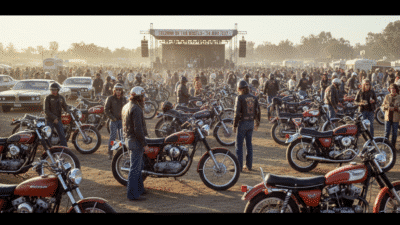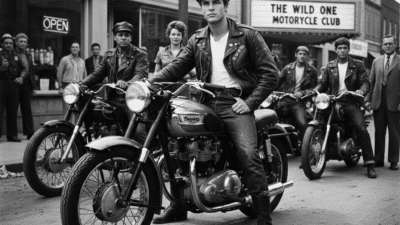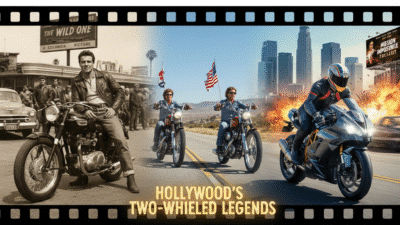The rumble of an uncorked exhaust, the glint of polished chrome, the low-slung stance of a machine built for speed and rebellion – this is the essence that defines the café racer culture and its origins. More than just a motorcycle style, it’s a timeless philosophy born from a unique blend of post-war austerity, burgeoning youth culture, and an insatiable desire for speed. It’s a story of young men in 1950s Britain, fueled by rock and roll and adrenaline, who sought to transform ordinary bikes into lean, mean racing machines capable of hitting “the ton”—100 miles per hour—between roadside cafes.
This wasn’t just about getting from A to B; it was about the journey, the thrill, and the statement. Café racers emerged from a specific time and place, embodying a spirit of individuality and performance that continues to captivate enthusiasts worldwide. It’s a testament to raw mechanical passion, where every component was scrutinized, stripped, or modified to enhance speed and handling, echoing a universal yearning for freedom on two wheels.
The Genesis: Post-War Britain and the Birth of a Movement
To truly understand the café racer, we need to rewind to the 1950s in post-World War II Britain. The war had ended, but its shadow lingered. Yet, amidst the rebuilding and recovery, a new generation was coming of age, seeking identity and excitement. Economic recovery brought a degree of prosperity, and for many young men, this meant acquiring a motorcycle. These weren’t just vehicles; they were symbols of newfound independence and freedom.
The cultural landscape was shifting dramatically. American rock and roll music, with its rebellious rhythms and electrifying energy, swept across the Atlantic, igniting a fire in British youth. Icons like Elvis Presley and Gene Vincent inspired a generation to challenge the status quo. This potent cocktail of independence and rebellion found its perfect expression in motorcycles.
The Ace Cafe and the “Ton-Up Boys”
At the heart of this burgeoning culture were roadside cafes, which served as natural gathering points for motorcyclists. Among these, the legendary Ace Cafe on the North Circular Road in London became an undisputed mecca. Open 24/7, it was a beacon for young riders, a place where they could meet, show off their bikes, listen to the latest rock and roll on the juke box, and, crucially, challenge each other to impromptu races.
These riders were known as “Ton-Up Boys” or “Rockers” – a nod to their love for rock and roll music and their leather-clad, greased-hair style. Their ultimate goal was to hit “the ton” (100 mph) on their bikes. The races, often spontaneous, involved riding from the cafe to a predetermined landmark and back before a single song finished on the jukebox. This was dangerous, exhilarating, and cemented the cafe racer’s reputation as a machine built for speed and daring. The bikes themselves started as production models, mostly British singles and twins from manufacturers like Triumph, Norton, BSA, and Royal Enfield, but they didn’t stay standard for long.
Defining the Machine: What Makes a Café Racer?
The term “café racer” didn’t just refer to the rider; it defined the bike itself. These weren’t factory-produced models initially, but rather heavily modified production bikes. The core philosophy was simple: strip away anything unnecessary, enhance performance, and improve handling. The result was a minimalist, athletic, and distinctly aggressive aesthetic.
Aesthetics and Functional Modifications
- Stripped-Down Minimalism: The mantra was “less is more.” Fenders were often shortened or removed, side panels discarded, and bulky seats replaced with sleek, single-person humps designed for speed.
- Clip-On Handlebars: These low-slung handlebars forced the rider into a forward, aerodynamic tuck, mimicking the posture of professional racers. They were a direct departure from the upright, comfortable bars of standard bikes.
- Rear-Set Footpegs: Moving the footpegs further back and up also contributed to the racing crouch, improving cornering clearance and control.
- Single Racing Seat: Often with a distinctive “bum-stop” or cowl, these seats were designed for a single rider and minimal drag.
- Large Fuel Tank: Typically a long, sculpted metal tank, often chrome or painted with racing stripes, it became a focal point of the bike’s design.
- Performance Enhancements: Engines were tuned for more power, lighter exhausts were fitted, and suspension systems were upgraded for better handling. Common engine modifications included high-compression pistons, performance camshafts, and upgraded carburettors.
The quintessential café racer often involved marrying a powerful engine to a superior frame, a practice famously exemplified by the “Triton” – a Triumph engine nestled within a Norton Featherbed frame. This Frankenstein approach was born from practicality and the pursuit of optimal performance, reflecting a deep understanding of automotive craftsmanship among these young customizers. This spirit of modification and personalization continues today, profoundly shaping modern car customization and the automotive industry.

The Rivalry: Mods vs. Rockers
No discussion of early café racer culture is complete without mentioning the iconic rivalry between the Mods and the Rockers. While both youth subcultures emerged in post-war Britain, their styles, philosophies, and chosen transportation were diametrically opposed.
- Mods: Short for “Modernists,” these youths embraced a sophisticated, often Italian-influenced style, favoring tailor-made suits, parkas, and smart haircuts. Their music taste leaned towards modern jazz, rhythm and blues, and later, soul and ska. Their preferred mode of transport was the Vespa or Lambretta scooter, often adorned with multiple mirrors and accessories. They were about style, precision, and group identity.
- Rockers: Also known as “Greaseers” or “Ton-Up Boys,” they were the direct antithesis. Dressed in leather jackets, jeans, and heavy boots, with greased-back hair, their aesthetic was rugged, rebellious, and distinctly American-influenced. Their music was rock and roll. And their ride? The customized, stripped-down, speed-focused café racer motorcycle.
The clashes between these two groups, famously documented at seaside towns like Brighton and Margate, were as much about defending their chosen subculture as they were about territory. For the Rockers, their café racer wasn’t just transport; it was an extension of their identity, a symbol of freedom, individuality, and raw power.
Pros and Cons of Embracing the Café Racer Culture
| Pros | Cons |
|---|---|
| – Timeless Aesthetic: Unique, classic, and always turns heads. | – Comfort Compromise: Aggressive riding posture can be uncomfortable on long rides. |
| – Personal Expression: Allows for extensive customization and individuality. | – Limited Practicality: Often single-seater with minimal cargo capacity. |
| – Engaging Ride: Direct connection to the road, pure motorcycling experience. | – Maintenance Demands: Older bikes require more upkeep and specialist knowledge. |
| – Strong Community: Part of a passionate global subculture. | – Performance Limitations: Older engines might not match modern bike power/reliability. |
| – DIY Satisfaction: The joy of building or modifying your own machine. | – Safety Concerns: Lack modern safety features found on newer bikes. |
Beyond the British Isles: Global Spread and Evolution
While the café racer was unequivocally born in Britain, its infectious spirit soon transcended geographical borders. The allure of speed, individual expression, and a distinctive aesthetic resonated with motorcyclists across Europe, North America, and particularly, Japan.
Japanese Influence and Modern Interpretations
As the 1960s rolled into the 70s, Japanese manufacturers began to dominate the motorcycle market with reliable, powerful, and affordable bikes. Brands like Honda, Kawasaki, Suzuki, and Yamaha started producing models that, while not explicitly “café racers,” lent themselves perfectly to the style. The Honda CB series, for instance, became a popular donor bike for customizers, proving that the café racer ethos was about modification, not just specific brands.
This global adoption led to an evolution of the style. While the core principles remained – stripped-down, performance-focused, and minimalist – different regions and eras brought their own interpretations. Modern custom builders continue to push boundaries, blending classic café racer elements with contemporary technology, performance upgrades, and innovative design. These creations stand as a testament to the enduring appeal of the raw, unadulterated motorcycling experience.

The Philosophy of Customization and Personal Expression
At its core, the café racer movement is a celebration of customization and personal expression. It’s a rebellion against the mass-produced, a commitment to making something uniquely your own. This DIY ethos is perhaps the most enduring legacy of the culture.
The Art of Stripping Away Excess
The early Rockers weren’t buying bespoke race bikes; they were taking everyday machines and transforming them. This meant understanding the mechanics, the physics, and the aesthetics of a motorcycle. Every modification was purposeful:
- A lighter exhaust meant more power and less weight.
- Clip-on handlebars and rear-sets improved aerodynamics and control.
- Stripping off unnecessary parts reduced weight and enhanced the lean, aggressive look.
This process forged a deep connection between rider and machine. You weren’t just riding a bike; you were riding your bike, a reflection of your personality and your mechanical ingenuity. It’s similar to how enthusiasts today meticulously maintain their vehicles, even undertaking tasks like inspecting and maintaining motorcycle fork seals or learning about basic motorcycle tool kit essentials to keep their machines running perfectly. This hands-on involvement makes the experience truly personal.

The Modern Resurgence: Why Café Racers Still Rule
The café racer culture isn’t just a historical footnote; it’s experiencing a massive resurgence today. Walk into any custom motorcycle show or browse online motorcycle forums, and you’ll see legions of stunning café racers, both vintage and modern. Why this enduring appeal?
Nostalgia, Authenticity, and Community
- Nostalgia for Simpler Times: In an increasingly complex and digital world, the café racer offers a tangible connection to a less complicated era. It’s about the pure, unadulterated joy of riding.
- Rejection of Over-Engineering: Many modern motorcycles are packed with electronics, rider aids, and elaborate bodywork. The café racer, by contrast, is a minimalist statement, a return to the raw essentials of motorcycling. It’s about the rider’s skill and connection to the machine, not complex algorithms.
- Strong Community: The culture fosters a vibrant, global community. From local meet-ups at cafes (how fitting!) to large-scale events and online forums, enthusiasts share tips, show off their builds, and ride together. This shared passion creates a powerful sense of belonging.
- Manufacturers Catching On: Recognizing the trend, many major motorcycle manufacturers now offer factory-built “modern classic” or “retro” models inspired by the café racer aesthetic. These bikes often blend vintage styling with modern performance and reliability, making the style accessible to a wider audience. This fusion of old and new reflects a broader trend in the evolution of car design from classic to modern.

Building Your Own Café Racer: A Journey of Passion
For many, the ultimate expression of engagement with café racer culture is to build one themselves. It’s a challenging, rewarding journey that demands patience, mechanical aptitude, and a clear vision.
The Process and Considerations
- Choosing a Donor Bike: The foundation of your project. Popular choices still include older Triumphs, Nortons, BSAs, and Japanese classics like Honda CBs, Suzuki GSs, and Kawasaki KZ/Z series. The key is finding a bike with a good engine and frame that can be stripped down.
- Developing a Vision: What aesthetic are you aiming for? Do you want a classic 60s look, a more modern interpretation, or something entirely unique? Sketching ideas and gathering inspiration is crucial.
- Key Modifications: This will involve replacing handlebars with clip-ons, installing rear-set footpegs, fabricating or buying a new seat and tail section, modifying or replacing the exhaust, and potentially upgrading suspension and brakes. Engine tuning is often part of the process to extract more performance.
- Safety and Legality: It’s vital to ensure all modifications are safe and comply with local regulations. Brakes, lighting, and tire condition are paramount.
- The Satisfaction: The process can be long and arduous, filled with skinned knuckles and head-scratching moments. However, the immense satisfaction of riding a machine you’ve personally built, tailored to your exact specifications, is unparalleled. It’s a tangible connection to the early Rockers who poured their hearts and souls into their machines.

Conclusion
The café racer culture and its origins are a powerful narrative of rebellion, ingenuity, and passion that began on the gritty streets of post-war Britain. From the “Ton-Up Boys” at the Ace Cafe striving for speed and personal freedom, to the global movement of custom builders and enthusiasts today, the spirit of the café racer endures. It’s more than just a motorcycle style; it’s a statement against conformity, a celebration of hands-on craftsmanship, and a testament to the timeless allure of the open road on a machine built for pure riding pleasure.
Whether you’re restoring a vintage classic, building a modern interpretation, or simply appreciating the stripped-down beauty of these machines, you’re tapping into a rich history that continues to inspire. The café racer is a symbol of individuality, a call to embrace the mechanical, and an invitation to experience the thrill of the ride in its purest form.
So, next time you see a sleek, minimalist motorcycle with clip-ons and a single seat, remember its rebellious past. It’s a machine born from a desire for speed, a soundtrack of rock and roll, and a culture that redefined what a motorcycle could be.
Frequently Asked Questions
What defines a true café racer motorcycle?
A true café racer is typically a production motorcycle that has been stripped down and modified for speed and handling. Key characteristics include low, clip-on handlebars, rear-set footpegs, a long fuel tank, a minimalist single seat often with a hump, and an overall stripped-down, aggressive aesthetic aimed at performance.
Where did the name “café racer” come from?
The term originated in 1950s Britain, referring to young motorcyclists who would race from one roadside cafe to another (often the Ace Cafe to a specific landmark and back) before a song finished on the juke box. These riders modified their bikes to achieve higher speeds, hence they were “racers” who frequented “cafes.”
Who were the “Ton-Up Boys”?
The “Ton-Up Boys” were the young, rebellious motorcyclists of 1950s and 60s Britain who were part of the Rocker subculture. Their goal was to achieve “the ton,” or 100 miles per hour, on their modified motorcycles. They were known for their leather jackets, greased hair, and love for rock and roll music.
What motorcycles were commonly used as donor bikes for café racers?
In the early days, popular donor bikes were British models like Triumph Bonnevilles, Norton Dominators, BSA Gold Stars, and Royal Enfields. Later, Japanese bikes such as the Honda CB series, Kawasaki Z series, and Suzuki GS series also became very popular due to their reliability and potential for customization.
Is the café racer culture still popular today?
Yes, the café racer culture is experiencing a significant resurgence. There’s a strong global community of enthusiasts who build, restore, and ride café racers. Many major motorcycle manufacturers also produce “modern classic” or “retro” bikes that incorporate the distinctive café racer styling cues, blending vintage aesthetics with modern performance.



